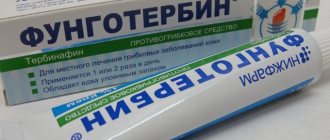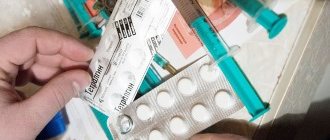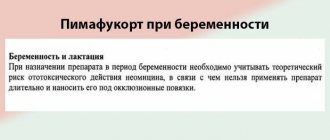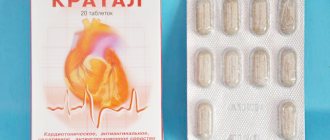Write a review
Reviews: 0
Manufacturers: Sagmel, Inc.
Active ingredients
- Paracetamol
- Chlorphenamine
Disease class
- Not indicated. See instructions
Clinical and pharmacological group
- Not indicated. See instructions
Pharmacological action
- Anti-inflammatory
- Antipyretic
- Vasoconstrictor (vasoconstrictor)
- Antiallergic
- Analgesic (non-narcotic)
Pharmacological group
- Anilides in combinations
Stock
active ingredients
: acetaminophen, phenylephrine hydrochloride, chlorpheniramine maleate;
1 tablet contains 325 mg acetaminophen, 5 mg phenylephrine hydrochloride and 2 mg chlorpheniramine maleate;
additional speeches
: microcrystalline cellulose, croscarmellose sodium, anhydrous silica, stearic acid, magnesium silicate, magnesium stearate, hypromelose, polyethylene glycol, mineral oil, barberry D&C yellow No. 10 varnishes y (E 104).
Medicine form. Tablets, coated with spit coating
Main physical and chemical properties: capsule-shaped tablet, yellow color, with clear foam coating and “AntiFlu” labels on one side
AntiFlu
AntiFlu (paracetamol + phenylephrine hydrochloride + chlorphenamine maleate) is a combination drug for the symptomatic treatment of acute respiratory viral infections (ARVI), where the word “symptomatic” means that the drug does not act on the cause of the disease, but on its consequence. Moreover, the latter is said absolutely not as a reproach to anti-Flu. The fact is that acute respiratory viral infections can be caused by many different viruses, which are often joined by all sorts of pathogenic bacteria. For this reason, it is often impossible to identify a specific causative agent of the disease in order to target it, and if we remember that drugs with proven antiviral activity can be counted on the fingers of one hand, then the futility of pathogenetic treatment in the vast majority of cases becomes obvious. But - closer to the point, that is, to anti-Flu. As noted above, this is a combination drug, the components of which are selected to cover all unpleasant cold symptoms. Paracetamol - has an analgesic, antipyretic and mild anti-inflammatory effect. Belonging to the group of alpha-adrenergic agonists, phenylephrine hydrochloride has a vasoconstrictor effect, relieves swelling and eliminates hyperemia of the mucous membrane of the nasal cavity and paranasal sinuses. Chlorphenamine maleate, a histamine receptor blocker of the H1 subtype, effectively relieves allergic symptoms and softens local exudative manifestations. To understand what taking antiFlu gives, it is necessary to take a closer look at the features of the course of ARVI. This group of diseases has both general (fever, weakness, headaches and muscle pain) and local (sore throat, cough, runny nose, rhinorrhea, sneezing) symptoms. The main symptom in this vivid picture, which is the primary reason for the patient to see a doctor, is objectively considered to be fever or an increase in body temperature to febrile levels.
Fever (hyperthermia) is a protective reaction of the body not an unauthorized invasion of various pathogens. It activates immune protective factors that prevent the total spread of infection. At the same time, when compensatory mechanisms are depleted, it can cause pathological conditions, which determines the need to prescribe antipyretic drugs. The drug of choice in this case is the non-steroidal anti-inflammatory drug paracetamol, which suppresses the synthesis of inflammatory mediators prostaglandins. A decrease in the concentration of the latter at the site of inflammation contributes to the gradual attenuation of the “fire” of the inflammatory process and the elimination of pain. “Cleansing” of prostaglandins from the cerebrospinal fluid entails normalization of body temperature. In recent years, combination medications for the relief of cold symptoms have become increasingly popular. The original drug AntiFlu is perhaps one of the most striking examples of the therapeutic benefits of the triple symbiosis of NSAIDs, alpha-adrenergic agonists and antihistamines.
AntiFlu is available in two dosage forms: tablets and powder for the preparation of a solution for oral administration. Adults and children aged 12 years and over are prescribed 1 tablet (1 sachet of powder) every 4 hours. The maximum daily dose should not exceed 8 tablets or 4 powders. For children under 12 years of age, a single dose of paracetamol is calculated based on the patient’s body weight: 10-15 mg per 1 kg. The duration of the medication course should be no more than 3 days. If your temperature remains high after this period of time, you should consult a doctor immediately. During treatment, you must refrain from drinking alcohol, taking tranquilizers and sleeping pills.
Pharmacological authorities
Pharmacodynamics.
Acetaminophen (paracetamol) has analgesic, antipyretic and mild anti-inflammatory effects. The mechanism of this action lies in the suppression of the synthesis of prostaglandins and influx on the center of thermoregulation in the hypothalamus.
Phenylephrine hydrochloride is an a-adrenergic agonist, which reduces swelling and hyperemia of the mucous membranes of the upper respiratory tract and paranasal sinuses.
Chlorpheniramine maleate is an antihistamine of the alkylamine class, a blocker of H1-histamine receptors. It has a protiallergic effect, relieves rhinorrhea, lacrimation and itching in the eyes and nose. The therapeutic effect develops over a period of 1 year after oral administration and lasts over a period of 24 years.
These drugs are metabolized independently of each other.
Pharmacokinetics.
After oral administration, acetaminophen is soaked in liquid, especially in the upper parts of the scolio-intestinal tract. Wine is easily distributed among fabrics. Binding with blood proteins becomes less than 10%. Acetaminophen is metabolized mainly in the liver: most of it is bound to glucuronic acid, the minority is bound to sulfuric acid. The withdrawal period for acetaminophen is 2-2.5 years. You will suffer especially from a liver disease.
Acetaminophen is administered intravenously (85% of a single dose of acetaminophen is administered over 24 years). Violence is seriously affected by the disruption of the visible function of the drug, which can lead to the accumulation of acetaminophen and the products of its metabolism in the body. The withdrawal period for chlorpheniramine maleate is 8 years. Metabolic products and the non-metabolized part of the drug are excreted.
Phenylephrine hydrochloride is often excreted unchanged and is inactivated by monoamine oxidase in the blood, liver and other tissues. Inactive products are often eliminated by nirk, or by liver in the form of glucuronides.
Antiflu oral tablets
Instructions for medical use of the drug
Description of pharmacological action
A combined agent, the effect of which is determined by the components included in its composition; has antipyretic, alpha-adrenergic, vasoconstrictor and antihistamine effects, eliminates cold symptoms. Paracetamol blocks COX mainly in the central nervous system, affecting the centers of pain and thermoregulation, which explains the almost complete absence of anti-inflammatory effect. The lack of influence of paracetamol on the synthesis of Pg in peripheral tissues determines the absence of a negative effect on water-salt metabolism (retention of Na+ and water) and the mucous membrane of the gastrointestinal tract. Phenylephrine is an alpha-adrenergic agonist, constricts blood vessels, eliminates swelling and hyperemia of the mucous membrane of the nasal cavity, nasopharynx and paranasal sinuses; reduces exudative manifestations. Chlorphenamine is an H1-histamine receptor blocker that suppresses the symptoms of allergic rhinitis: sneezing, rhinorrhea, itching of the eyes, nose, and throat. Onset of action is 20–30 minutes, duration is 4–4.5 hours.
Indications for use
Feverish syndrome (“colds” and infectious diseases). Sinusitis, rhinorrhea (acute rhinitis, allergic rhinitis).
Release form
film-coated tablets; blister 12, cardboard pack 1;
Pharmacodynamics
Combined drug. Paracetamol has an analgesic, antipyretic and mild anti-inflammatory effect. Phenylephrine hydrochloride, an alpha-adrenergic agonist, has a vasoconstrictor effect, reduces swelling and hyperemia of the nasal mucosa and paranasal sinuses. Chlorphenamine maleate is a histamine H1 receptor blocker. It has an antiallergic effect, reduces the severity of local exudative manifestations, eliminates lacrimation, itching in the eyes and nose.
Use during pregnancy
Contraindicated.
Contraindications for use
Hypersensitivity; pregnancy, lactation period; children's age (up to 6 years).
Side effects
Allergic reactions (skin rash, itching, urticaria, angioedema), nausea, epigastric pain; anemia, thrombocytopenia, agranulocytosis. Increased excitability, dizziness, increased blood pressure, difficulty falling asleep. Mydriasis, accommodation paresis, increased intraocular pressure, dry mouth; urinary retention. With long-term use in large doses - hepatotoxic effect, hemolytic anemia, aplastic anemia, methemoglobinemia, pancytopenia; nephrotoxicity (renal colic, glycosuria, interstitial nephritis, papillary necrosis).
Directions for use and doses
Adults and children over 12 years old - 1 tablet. every 4 hours, but not more than 8 tablets. per day. Single doses for children depend on body weight (10–15 mg of paracetamol per 1 kg of child’s body weight) and the age of the child and are approximate. Children from 6 to 12 years old - 1 tablet. 2 times a day, with an interval between doses of at least 6 hours.
Overdose
Symptoms (caused by paracetamol, appear after taking more than 10–15 g): pale skin, loss of appetite, nausea, vomiting; hepatonecrosis; increased activity of “liver” transaminases, increased prothrombin time. Treatment: gastric lavage in the first 6 hours, administration of SH-group donors and precursors for the synthesis of glutathione-methionine 8–9 hours after overdose and N-acetylcysteine after 12 hours.
Interactions with other drugs
Enhances the effects of MAO inhibitors, sedatives, ethanol. Ethanol enhances the sedative effect of antihistamines. Antidepressants, phenothiazine derivatives, antiparkinsonian and antipsychotic drugs increase the risk of developing urinary retention, dry mouth, and constipation. GCS increase the risk of developing glaucoma. Paracetamol reduces the effectiveness of uricosuric drugs. Chlorphenamine simultaneously with MAO inhibitors and furazolidone can lead to hypertensive crisis, agitation, and hyperpyrexia. Tricyclic antidepressants enhance the adrenomimetic effect of phenylephrine; simultaneous administration of halothane increases the risk of developing ventricular arrhythmia. Reduces the hypotensive effect of guanethidine, which in turn enhances the alpha-adrenergic stimulating activity of phenylephrine.
Special instructions for use
If hyperthermia lasts more than 3 days and pain lasts more than 5 days, consult a doctor. The risk of developing liver damage increases in patients with alcoholic hepatosis. Distorts laboratory test results in the quantitative determination of glucose and uric acid in plasma. In case of long-term treatment, peripheral blood parameters and the functional state of the liver are monitored. During the treatment period, it is necessary to refrain from drinking ethanol (possible development of hepatotoxic effects), driving vehicles and engaging in other potentially hazardous activities that require increased concentration and speed of psychomotor reactions.
Storage conditions
In a dry place, at a temperature of 15–25 °C. Keep out of the reach of children.
Best before date
36 months
ATX classification:
N Nervous system
N02 Analgesics
N02B Analgesics and antipyretics
N02BE Anilides
N02BE51 Paracetamol in combination with other drugs (excluding psycholeptics)
Contraindicated
Increased individual sensitivity to the ingredients of the drug; manifestations of impaired liver and liver function; birth deficiency of glucose-6-phosphate dehydrogenase (hemolytic anemia); Gilbert's syndrome (alternating benign diarrhea, which is due to a deficiency of glucuronyl transferase); destruction of the blood supply; blood disease; leukopenia is expressed; anemia; severe damage to cardiac conduction; decompensated heart failure; manifestations of atherosclerosis of the veins of the heart; severe form of ischemic heart disease; severe form of arterial hypertension; bronchial asthma; congenital hyperbilirubinemia; Dubin-Johnson syndrome; blood diabetes; hyperthyroidism; postcutaneous glaucoma; obstruction of the neck of the mikhur; piloroduodenal obstruction; Virazkova ailment at the stage of infection; alcoholism; arrhythmias; adenoma of the anterior pelvis with difficulty in cutting; gostria pancreatitis; increased restlessness; disturbed sleep; pheochromocytoma; epilepsy. Summer century. Patients with risk of respiratory failure.
Do not combine with monoamine oxidase inhibitors (MAO) and for 2 days after administration of MAO inhibitors; with tricyclic antidepressants, ß-blockers.
Similar drugs:
- Spasmalgon Tablets
- ARTRADOL (Artradol) Lyophilisate for the preparation of solution for injection
- Dicloberl N 75 (Dicloberl N 75) Solution for injection
- Next Oral tablets
- Nalbuphine Solution for injection
- Panoxen Oral tablets
- Katadolon Capsule
- Meloxicam Solution for intramuscular administration
- Optalgin Oral tablets
- Butadion Oral tablets
** The Drug Directory is intended for informational purposes only. For more complete information, please refer to the manufacturer's instructions. Do not self-medicate; Before starting to use AntiFlu, you should consult a doctor. EUROLAB is not responsible for the consequences caused by the use of information posted on the portal. Any information on the site does not replace medical advice and cannot serve as a guarantee of the positive effect of the drug.
Are you interested in AntiFlu? Do you want to know more detailed information or do you need a doctor's examination? Or do you need an inspection? You can make an appointment with a doctor - the Euro lab is always at your service! The best doctors will examine you, advise you, provide the necessary assistance and make a diagnosis. You can also call a doctor at home . Euro lab clinic is open for you around the clock.
** Attention! The information presented in this medication guide is intended for medical professionals and should not be used as a basis for self-medication. The description of the drug AntiFlu is provided for informational purposes and is not intended for prescribing treatment without the participation of a doctor. Patients need to consult a specialist!
If you are interested in any other drugs and medications, their descriptions and instructions for use, information about the composition and form of release, indications for use and side effects, methods of use, prices and reviews of drugs, or you have any other questions and suggestions - write to us, we will definitely try to help you.
Features of good stagnation
The difference between one-hour ingestion and other drugs used for symptomatic treatment of colds and flu, medicinal methods that replace paracetamol.
This medication is not recommended to be combined simultaneously with sedatives, anesthetics, or medications to replace alcohol, due to the increased risk of hepatotoxicity.
It is advisable to take paracetamol, which due to hepatotoxicity cannot be taken in higher doses, as recommended in the section “Method of administration and dosage”. Trivalium intake can lead to severe problems with the side of the liver, such as cirrhosis. Acute or chronic overdose can lead to severe liver damage and, in isolated episodes, to death.
Trivalent use of paracetamol, especially in combination with other analgesics, can lead to permanent impairment and risk of development of nicotine deficiency (analgesic nephropathy).
Trivalent use of paracetamol in high doses can lead to liver and liver damage. A large number of medications that can become stagnant at the same time, alcoholism, alcoholism of the liver, sepsis or blood diabetes may increase the risk of hepatotoxicity of paracetamol at therapeutic doses. The risk of overdose occurs in patients with non-cirotic alcoholic diseases of the liver.
If the doctor recommends using the drug throughout the treatment period, it is necessary to monitor the functional state of the liver and peripheral blood patterns.
In patients with severe infections, such as sepsis, which are accompanied by a decrease in glutathione levels, when taking paracetamol, there may be a risk of metabolic acidosis (section “Overdose”).
Before taking the drug, it is necessary to consult with a doctor:
- if the patient is taking warfarin or similar drugs that may have an anticoagulant effect;
- if the patient has problems with breathing, chronic illness, emphysema or chronic bronchitis.
- if the patient suffers from liver disease or infectious liver disease, such as viral hepatitis;
- if the patient suffers from illness, a dose adjustment may be required. In cases of severe nicotine deficiency (creatinine clearance ˂ 10 ml/min), the doctor should evaluate the reaction rate/corrosiveness before the drug is administered. It is necessary to adjust the dose to ensure continuous monitoring;
̶ with arterial hypertension;
̶ in case of depletion of analgesics for mild arthritis.
Advise patients to be careful:
̶ due to the presence of chronic malnutrition and illness;
̶ with hepatic insufficiency of the lung and the middle level of severity (˂ 9 points on the Child-P'yu scale);
̶ with Reynaud's disease;
̶ diseases of the thyroid gland;
̶ glaucoma.
Slide to the doctor:
̶ if the symptoms are unknown and/or accompanied by a high temperature that lasts for more than 3 days;
- as the headache becomes calmer.
Episodes of severe mental reactions were rarely reported. If the skins are blackened, sagging, puffy or peeled appear, it is necessary to take paracetamol and immediately seek medical help.
The use of paracetamol in therapeutic doses may lead to an increase in ALT.
Paracetamol can be combined with blood glucose and sechoic acid based on laboratory results.
Do not overdo the prescribed dose.
Suspension during pregnancy or breastfeeding.
It is not recommended to stop taking medication during pregnancy.
For women, after taking the drug, they should wash their breasts.
Fertility.
ISNETE OF THE EVERYTHING OF THE STOSELY MISTICAL OF THE FERTIONSTISTISTICAL, WITH HAVEN OF OUTH DRUE, YAKIY INGIBIUT synthesis of cyclooxygenasi/prostaglandin, MAH MAY CHILD IN THE RESISKAYAL VIDMILY LIKUVANNYA. It is believed that paracetamol inhibits prostaglandin synthesis and may have a negative impact on fertility, although such episodes occur daily.
This is due to the fluidity of the reaction during treatment with vehicles or other mechanisms.
Through the possibility of guilt, drowsiness can be eliminated during treatment using transport means or robots with mechanisms for 4 years after the drug has been infused.
Overdose
Symptoms of overdose, associated with acetaminophen, in the first 24 years of age include pale skin, fatigue, vomiting, anorexia and abdominal pain. When taking large doses, you may also experience disturbances in orientation, psychomotor restlessness or suppression of the central nervous system, increased sweating, confusion and sleep disturbance. Heart rhythm disturbances and pancreatitis were also noted.
In isolated cases, after acetaminophen overdose, acute nitric deficiency was reported due to acute tubular necrosis, which can manifest as severe pain in the spine, hematuria, proteinuria, and progression to drink in the presence of severe liver disease; nephrotoxicity (nic colic, interstitial nephritis, papillary necrosis).
In severe episodes, especially with immediate alcohol use, there may be damage to the liver (hepatocellular necrosis) and impairment of its function, which can progress to hepatic encephalopathy, hepatic coma, brain swelling where are the lethal inheritances? Clinical signs of liver damage may not appear for 12-48 years after overdose. Possible causes include impaired glucose metabolism, hypokalemia and metabolic acidosis (including lactic acidosis). Symptoms of metabolic acidosis include severe, accelerated or difficult breathing, boredom, vomiting, loss of appetite. It is important to consult a doctor once these symptoms appear. Increased activity of “liver” transaminases and increased prothrombin index, blood flow. Liver damage in an adult can develop after taking 10 g or more paracetamol and over 150 mg/kg body weight in a child. Some clinical manifestations that appear after 3-5 days include fever, hemorrhagic disease, hypoglycemia, bad breath, liver failure.
Taking 5 g or more paracetamol can lead to liver damage in patients with risk factors (trival treatment with carbamazepine, phenobarbital, phenytoin, primadone, rifampicin, St. John's wort or other drugs in what ways do liver enzymes induce; regular intake of high amounts of ethanol; glutathione cachexia (disorders etching, cystic fibrosis, HIV infection, fasting, cachexia).
In case of severe ingestion at high doses, aplastic anemia, pancytopenia, agranulocytosis, neutropenia, leukopenia, thrombocytopenia are possible.
Unexpected help. The patient should be immediately taken to the doctor for early symptoms of overdose. Symptoms may be between nausea and vomiting, or may not reflect the severity of overdose or the risk of organ damage. The following was examined for the treatment of active vugillas, since an overdose of paracetamol was taken within 1 year. The concentration of paracetamol in blood plasma should disappear after 4 years or later after administration (higher early concentrations are unreliable). Rinse the tube for 6 years after a suspected overdose of acetaminophen. Cytostatic effects can be modified by oral administration of methionine or internal administration of cysteamine or N-acetylcysteine for 8 years after overdose. The effectiveness of the antidote sharply decreases after this hour.
Overdose with phenylephrine and chlorpheniramine maleate
, may cause sweating, psychomotor restlessness or depression of the central nervous system, restlessness, restlessness, headache, confusion, drowsiness, insomnia, tiredness, vomiting, tremor, impaired fluid speed, fatigue heart rhythm, tachycardia, extrasystole, hyperreflexia, arterial pressure, judge who.
When overdosing chlorpheniramine maleate, atropine-like symptoms may be avoided: mydriasis, photophobia, dry skin and mucous membranes, increased body temperature, intestinal atony. Suppression of the central nervous system is accompanied by respiratory disorders and dysfunction of the cardiovascular system (changes in pulse rate, changes in arterial pressure, even to vascular insufficiency).
In case of overdose, symptomatic therapy is necessary; in case of severe arterial hypertension, the use of α-blockers is necessary.
Side effects
In most people with seizures, the drug is tolerated well.
In rare cases, the onset of unwanted effects may be avoided after severe stagnation in quantities that exceed the recommended additional dose:
on the side of the blood and lymphatic system
– anemia, sulfhemoglobinemia and methemoglobinemia (cyanosis, dyspnea, heart pain), hemolytic anemia (if the patient has a deficiency of glucose-6-phosphate dehydrogenase), thrombocytopenia, agranulocytosis , leukopenia, sinuses and bleeding;
on the side of the scolio-intestinal tract –
baking, fatigue, vomiting, dry mouth, discomfort and pain in the epigastric region, hypersalivation, decreased appetite, constipation, diarrhea, flatulence;
on the side of the hepatobiliary system
– impaired liver function, increased activity of liver enzymes, usually without development of hepatitis, hepatonecrosis (dose-dependent effect);
on the side of the endocrine system
– hypoglycemia up to hypoglycemic coma;
on the side of the immune system
– hypersensitivity reactions (including allergic reactions), anaphylactic reactions and anaphylactic shock;
from the side of the nervous system
– headache, weakness, confusion, psychomotor restlessness and disorientation, restlessness, fear, sleep disorders (drowsiness, insomnia), dyskinesia, behavioral changes, twitchiness or nervousness eating, tremor, confusion of information, depression, feeling of prickling and importance in the endings , vomiting noise, hallucinations, epileptic attacks, coma;
on the side is the nirok and Sich shlyakhs
– nitric colic and interstitial nephritis, blockage of the cuticle and difficulty in discharge, aseptic puria;
from the side of the organs
– impaired vision and accommodation, dry eyes, mydriasis;
from the side of the skin and under the skin fabrics
– itching, hanging on the skin and mucous membranes (zavichy, generalized visip, erythema, kropivyanka), allergic and angioedema, acute generalized exanthematous pustulosis, local drug-induced dermatitis, erythema multiforme (including l Stevens-Johnson syndrome), toxic epidermal necrolysis (Lyell's syndrome), including lethal inheritances;
from the side of the cardiovascular system
– tachycardia, reflex bradycardia, shortness of breath, heart pain, arterial pressure, arrhythmia, myocardial dystrophy (dose-dependent effect in case of severe congestion);
from the side of the dicholic system
– bronchospasm in patients with hypersensitivity to acetylsalicylic acid and other non-steroidal anti-inflammatory drugs.








